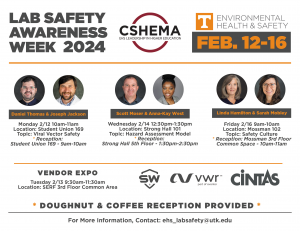
EHS-Lab Safety Services is excited to announce that Lab Safety Awareness Week is coming February 12-16! Please join us for the following events:
Monday, February 12th 10:00- 11:00 Student Union 169: Viral Vector Safety talk by Daniel Thomas and Joseph Jackson
9:00- 10:00 Student Union 169 Doughnut & Coffee Reception with LSS
Tuesday, February 13th 9:30- 11:30 SERF 3rd floor: Vendor Expo + Doughnuts & Coffee with LSS
Wednesday, February 14th 12:30- 1:30 Strong Hall 101: Hazard Assessment Model talk by Scott Moser and Anna-Kay West
1:30-2:30 Strong Hall 5th floor Doughnut & Coffee Reception with LSS
Friday, February 16th 9:00- 10:00 Mossman 102: Safety Culture talk by Linda Hamilton and Sarah Mobley
10:00- 11:00 Mossman 3rd floor: Doughnut & Coffee Reception with LSS
As an incentive for attending, we will be giving away a door prize at each talk!
Please help us spread the word by sending this to other researchers and members of your lab!
If you have any questions, please reach out to us at ehs_labsafety@utk.edu
